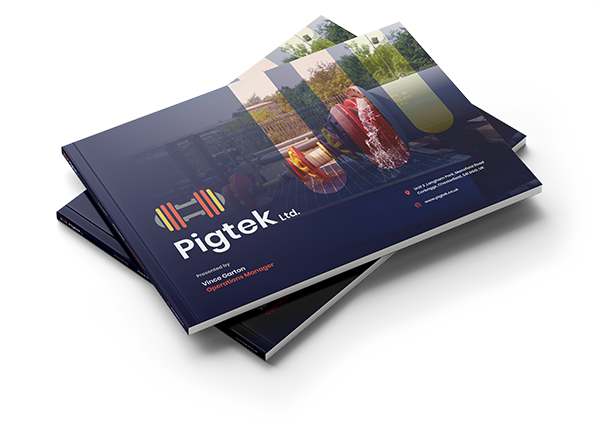Heavy-Duty Cleaning Pigs and Ancillary Pigging Equipment for Hire
With more than 200 heavy-duty pigs of various sizes and types in stock, Pigtek Ltd has a fleet of equipment ready for immediate hire. Equipment is configured to suit each pigging project, with careful sizing of components such as discs and brushes. Rapid modifications can also be performed, when necessary, to prepare equipment for such applications as housing transmitters, negotiating 1.5D bends and dual diameter pigging.
A comprehensive stock of ancillary pigging equipment including transmitters and pig detection equipment compliments the hire fleet to enable a complete package to be hired to fulfil most pigging operations.
In addition to the hire fleet, Pigtek can also provide experienced field personnel to operate equipment and supervise the pigging operation on-site throughout the UK and the rest of the world.
Pigtek Ltd are a specialist pigging company based in the UK that focus on supplying heavy-duty equipment for applications where “standard” or “proprietary” products are simply unable to perform or are proving to be inefficient. This may be due to extreme debris problems, unknown pipeline conditions or diverse pipeline features such as Wye pieces, multi/dual diameter pipe sizes or long distance. Products are available on a sale or hire basis in sizes from 6” through to 56” and include the following:
- Flexi-Cupped Gauging Pigs

- High Sealing Batching / Separation Pigs
- Magnetic Cleaning Pigs
- Brush Cleaning Pigs
- Heavy-Duty Brush Cleaning Pigs
- HDR (Hard Deposit Removal) Pin Pigs
- Dual Module Pigs
- Above Ground Magnetic Pig Tracking Equipment
- Acoustic Pig Detection Equipment
- Transmitters and Transmitter Receiver Units
Pipeline Cleaning
 Regular pigging programmes are often performed on pipelines to reduce the level of debris and in turn, to maintain the performance of the pipeline from an operational point of view. However, the level of cleanliness achieved may not be sufficient to enable an in-line or smart inspection run to be performed successfully. Depending on the quantity and consistency, debris such as wax, scale, dust, sand and sludge even in relatively small quantities, can seriously downgrade the data available from an inspection pig and in many cases the debris will cause damage to the pig. This can result in downtime to clean, repair and re-build equipment in addition to a costly re-run. So, even if the level of cleanliness within a pipeline is acceptable from an operational point of view, it is highly recommended to thoroughly clean the line using heavy-duty cleaning pigs prior to inspection. Hiring heavy-duty cleaning equipment prior to the inspection operation enables the pipeline operator to perform intensive cleaning over a short duration to condition the line ready for inspection.
Regular pigging programmes are often performed on pipelines to reduce the level of debris and in turn, to maintain the performance of the pipeline from an operational point of view. However, the level of cleanliness achieved may not be sufficient to enable an in-line or smart inspection run to be performed successfully. Depending on the quantity and consistency, debris such as wax, scale, dust, sand and sludge even in relatively small quantities, can seriously downgrade the data available from an inspection pig and in many cases the debris will cause damage to the pig. This can result in downtime to clean, repair and re-build equipment in addition to a costly re-run. So, even if the level of cleanliness within a pipeline is acceptable from an operational point of view, it is highly recommended to thoroughly clean the line using heavy-duty cleaning pigs prior to inspection. Hiring heavy-duty cleaning equipment prior to the inspection operation enables the pipeline operator to perform intensive cleaning over a short duration to condition the line ready for inspection.
Pipeline Clearance
A High-Sealing Batching / Separation Pig is essential for an effective pipeline clearance operation, but other aspects such as pipeline gauging, pig tracking and pig location may have to be considered. Pigtek have vast experience in preparing pigs ready for hire, fitted with permanent magnets to enable pig tracking, a transmitter to enable pig location and an aluminium gauging plate to determine the minimum internal bore. Pig tracking equipment can also be hired or alternatively Pigtek can provide a complete service, including pig supply and pig tracking services.
Knowing the location of a pig whilst it is travelling through a pipeline may simply provide a sense of re-assurance, but can also be critical in some pigging operations. A line clearance operation to evacuate product from the pipeline may depend on knowing the location of the pig at any time during the run. Break tanks, filters and silencers may be installed at the receiver site, connected to the pipeline by temporary pipework – when the pig is less than 1 km. from the receiver, or when product starts to become discoloured, the flow may be diverted through the temporary pipework to prevent contaminated product entering the main process system. Regular tracking to detect the pig along the pipeline route will provide critical information such as velocity and estimated time of arrival. Alternatively in the case of line clearances, to prevent a complete pipeline being evacuated, a pig may be run until it passes downstream of an isolation valve. Without detecting the pig as it travels through the pipeline for this type of operation, the position of the pig would not be known. However, tracking the pig will provide prior warning and the pig can be detected as it passes directly through the isolation valve.
If a pipeline has never been previously pigged or if large quantities of debris are present, then pig tracking will again provide re-assurance in knowing the position of the pig within the pipeline. In the event that the pig becomes stuck, the location of the pig will be known to be somewhere between the last tracking location and the location that it failed to reach. This greatly cuts down the search area when looking for a pig. The exact position of a stuck pig can be detected and confirmed if the pig is fitted with a transmitter. The transmitter emits an electromagnetic field that can be detected with a portable detection unit. Therefore, to reduce the potential search area in the event of a stuck pig, it is good practice not to exceed more than 5 km. between tracking locations. However, much will depend on access and velocity of the pig.
![]() Above Ground Magnetic Pig Tracking Equipment together with Acoustic Monitoring Equipment can be used to detect the pig. Prior to commencing the pigging operation, tracking locations should be identified and established to ensure access and suitability. It is good practice to utilise two teams of tracking engineers in a “leap frog” technique to ensure that one team is always ahead of the pig; tracking team 1 would start at location 1, whilst tracking team 2 would be at location 2. When the pig has passed location 1, tracking team 1 would move to location 3. This technique should be continued as the pig travels through the pipeline until it reaches the receiver or point at which it will be stopped.
Above Ground Magnetic Pig Tracking Equipment together with Acoustic Monitoring Equipment can be used to detect the pig. Prior to commencing the pigging operation, tracking locations should be identified and established to ensure access and suitability. It is good practice to utilise two teams of tracking engineers in a “leap frog” technique to ensure that one team is always ahead of the pig; tracking team 1 would start at location 1, whilst tracking team 2 would be at location 2. When the pig has passed location 1, tracking team 1 would move to location 3. This technique should be continued as the pig travels through the pipeline until it reaches the receiver or point at which it will be stopped.
Above Ground Magnetic Pig Tracking Equipment can be used to track most types of steel bodied pigs and also polly pigs, providing that they are fitted with a small magnet. The equipment operates on the principal of detecting a change in magnetic field as a pig passes through the pipeline, beneath the sensor. The system will successfully track pigs through a depth of ground cover up to 3 metres. For best results, pigs should be fitted with permanent magnets to enable detection. The equipment is powered by 12 volt DC, which is either taken from a vehicle power supply or from a stand-alone dryfit battery.
The system consists of the following components:
- Control/Monitoring Unit c/w strip chart recorder
- Remote sensor
- Connecting leads
- 12 Volt DC Battery
The control/monitoring unit is situated adjacent to the tracking location and can be easily accommodated in a vehicle. The remote sensor is then placed on or near to the point where the pig is to be tracked. The sensitivity of the sensor can be manually adjusted to suit operating conditions such as pig type and ground cover. The sensor is connected back to the control/monitoring unit by cable.
 Acoustic Monitoring Equipment is a portable pig tracking system that enables the movement of a pig to be heard as it travels towards the tracking location. The sensor detects low energy pulses on the pipewall and amplifies the signal through the control unit to produce an audio output via headphones. The pulses are generated when the cups or discs of a pig encounter internal weld beads between the pipes and fittings.
Acoustic Monitoring Equipment is a portable pig tracking system that enables the movement of a pig to be heard as it travels towards the tracking location. The sensor detects low energy pulses on the pipewall and amplifies the signal through the control unit to produce an audio output via headphones. The pulses are generated when the cups or discs of a pig encounter internal weld beads between the pipes and fittings.
This system comprises of the following components:
- Control Unit
- Acoustic Sensor
- Connecting Leads
- Headphones
The sensor is either placed directly onto the pipeline or in the ground above the pipeline and is then connected to the monitoring unit by cable. Volume and sensitivity can be manually adjusted to suit the operating conditions or until the best signal from the pig is heard. In good conditions it is possible to hear the pig at a distance of up to 10 km from the sensor.
This equipment will allow the operator to assess whether the pig is moving steadily through the pipeline and by timing the noise between welds, the operator can establish the approximate velocity of the pig.
Summary
Hiring equipment enables a pipeline operator to utilise high performance equipment at a proportionally lower cost than having to purchase equipment outright. Further benefits are that the pipeline operator does not have to maintain equipment or keep a sufficient stock of spares, as the equipment is simply returned on completion of the project. Outsourcing the supply of pigging equipment also enables the operator to concentrate on the core project task such as internal inspection or repair works. Contact us here at Pigtek Ltd to hire professional pigging equipment or call us on +44 (0) 1246 850220
 Pigtek Ltd
Pigtek Ltd





